![]()
![]()
![]()
Use LEFT and RIGHT arrow keys to navigate between flashcards;
Use UP and DOWN arrow keys to flip the card;
H to show hint;
A reads text to speech;
22 Cards in this Set
- Front
- Back
|
DNA Sequencing |
The proccess that allows for the nucleotide base sequence of an organisms genetic material to be indentified and recorded. |
|
|
The Chain Termination Method (Sanger Sequencing) |
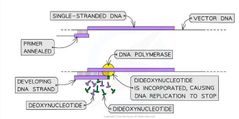
Uses modified nucleotides called dideoxynucleotides. Dideoxynucleotides have a slightly different structure to nucleotides found within an organisms DNA. They pair with the complementary bases and when DNA polymerase encounters one it stops replicating. |
|
|
High-throughput sequencing |
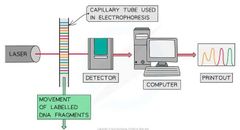
Uses chain-termination in fragment seperation. Each dideoxynucleotide is labelled with a fluorescent dye. The single-stranded DNA chains are seperated via electrophoresis. A laserbeam is used to illuminate the dideoxynucleotides and a detector reads the colour and position. |
|
|
Next-generation sequencing |
Any method of DNA Sequencing that has replaced the Sanger method e.g Nanopore is reffered to as next-generation sequencing (NGS). They are one thousand times faster than older methods. |
|
|
Sequencing DNA to determine Protein Sequences |
The genetic code can be used to predict Amino Acids sequences, which allows scientists to predict how the protein will fold into its tertiary structure. |
|
|
Bioinformatics |

A field of biology that involves the storage, retrival and analaysis of data from biological studies e.g DNA Sequences, RNA Sequences and Protein Sequences. It can also be used to assess the relationship between genotype and phenotype. |
|
|
Epidemiology |
This is the study of the spread of infectious disease within populations, the genomes of pathogens can be sequenced and anlaysed to aid research and disease control. |
|
|
The Human Genome Project |
A genome project works by collecting DNA samples from many individuals of a species, they are then compared to create a reference genome. The project has helped tackle health issues, cure diseases and also identifying the likelihood of inheriting certain diseases. |
|
|
Synthetic Biology |
An area of research aimed to create new biological parts, devices and systems. It goes beyond genetic engineering, as it involves large alterations to an organisms genome. |
|
|
Polymerase Chain Reaction (PCR) |
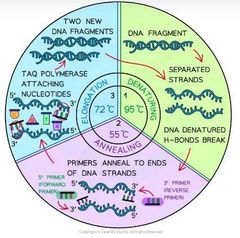
A common molecular biology technique used in most applications of gene technology e.g DNA Profiling. It is used to produce large quantities of specific fragments of DNA or RNA from small quantities. |
|
|
Requirements of PCR |

Target DNA/RNA, DNA Polymerase, Free Nucleotides and a Buffer Solution. |
|
|
Denaturation (PCR) |
The double- stranded DNA is heated to 95C which breaks the hydrogen bonds that bond the two DNA strands together |
|
|
Annealing (PCR) |
The temperature is decreased to between 50-60C so that primers can anneal (join) to the ends of the single strands of DNA. |
|
|
Elongation/ Extension (PCR) |
The temperature is increased to 72C for at least a minute, this is the optimum temperature for Taq Polymerase to build the complementary strands of DNA via free nucleotides to produce the new identical double-stranded DNA molecules. |
|
|
Electrophoresis |
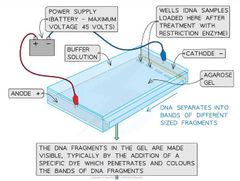
A technique used to analyse DNA, RNA and proteins. The molecules are seperated according to their size/mass and their charge. The seperation occurs as: positively charged molecules move toward the cathode and negatively charged molecules move to the anode, the smaller molecules move faster than larger molecules. |
|
|
DNA Profiling |
Also known as Genetic Fingerprinting enables scientists to identify suspects for a crime or identify corpses because everyone (apart from identical twins), has short non-coding regions of DNA that are unique to them - Variable Number Tandem Repeats (VNTRs). |
|
|
Genetic Engineering |
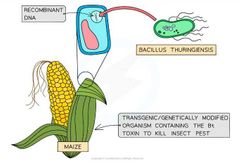
A term usually used to refer to the manipulation of the DNA sequences of an organism. Used in process' such as Synthetic Biology. |
|
|
Recomibiant DNA |
The method of joinig two or more DNA molecules to create a hybrid. |
|
|
Transgenic Organism |
An organism or cell whose genome has been altered by the introduction of one or more foreign DNA Sequences e.g Recombinant DNA. |
|
|
Uses of Genetic Engineering |
Crops: Increase yield, resistance to drought and disease, increase nutritional value. Livestock: disease and pest resistance, increase productivity. Bacteria: Produce medicines e.g Insulin, decompose toxic pollutants, carry out large scale chemical production. |
|
|
Arguments against Genetic Engineering |
Lack of research into impacts on human health, may contaminate nearby crops, reduction in biodiversity, invade natural habitats, may lead to mutations. |
|
|
Gene Therapy |
Using various mechanism to alter a persons genetic material to treat or cure diseases. Somatic Gene Therapy is targeted on body cells, this can either be ex vivo (outside the body) or in vivo (inside the body). |

